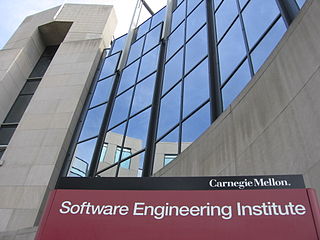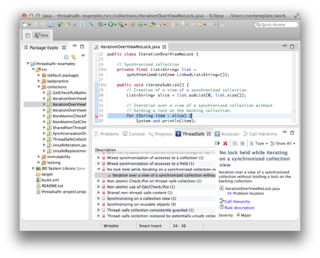Related Research Articles

The Software Engineering Institute (SEI) is an American research and development center headquartered in Pittsburgh, Pennsylvania. Its activities cover cybersecurity, software assurance, software engineering and acquisition, and component capabilities critical to the Department of Defense.
Uncontrolled format string is a type of software vulnerability discovered around 1989 that can be used in security exploits. Originally thought harmless, format string exploits can be used to crash a program or to execute harmful code. The problem stems from the use of unchecked user input as the format string parameter in certain C functions that perform formatting, such as printf . A malicious user may use the %s and %x format tokens, among others, to print data from the call stack or possibly other locations in memory. One may also write arbitrary data to arbitrary locations using the %n format token, which commands printf and similar functions to write the number of bytes formatted to an address stored on the stack.
In the context of software engineering, software quality refers to two related but distinct notions:
Application security encompasses measures taken to improve the security of an application often by finding, fixing and preventing security vulnerabilities.
Software assurance (SwA) is defined as "the level of confidence that software is free from vulnerabilities, either intentionally designed into the software or accidentally inserted at any time during its lifecycle, and that the software functions in the intended manner."

The CERT Coordination Center (CERT/CC) is the coordination center of the computer emergency response team (CERT) for the Software Engineering Institute (SEI), a non-profit United States federally funded research and development center. The CERT/CC researches software bugs that impact software and internet security, publishes research and information on its findings, and works with business and government to improve security of software and the internet as a whole.
MISRA C is a set of software development guidelines for the C programming language developed by MISRA. Its aims are to facilitate code safety, security, portability and reliability in the context of embedded systems, specifically those systems programmed in ISO C / C90 / C99.

Robert C. Seacord is an American computer security specialist and writer. He is the author of books on computer security, legacy system modernization, and component-based software engineering.
Coding conventions are a set of guidelines for a specific programming language that recommend programming style, practices, and methods for each aspect of a program written in that language. These conventions usually cover file organization, indentation, comments, declarations, statements, white space, naming conventions, programming practices, programming principles, programming rules of thumb, architectural best practices, etc. These are guidelines for software structural quality. Software programmers are highly recommended to follow these guidelines to help improve the readability of their source code and make software maintenance easier. Coding conventions are only applicable to the human maintainers and peer reviewers of a software project. Conventions may be formalized in a documented set of rules that an entire team or company follows, or may be as informal as the habitual coding practices of an individual. Coding conventions are not enforced by compilers.
In computer science, attack patterns are a group of rigorous methods for finding bugs or errors in code related to computer security.
Dentrix was the first dental practice management software for Microsoft Windows when it was launched in 1989 by Dentrix Dental Systems, a firm founded by Larry M. Gibson in 1985 and is based in American Fork, Utah. The Dentrix dental practice management system was designed to automate as many of the functions within the dental office as possible.
A Zero-day vulnerability is a computer-software vulnerability that is unknown to, or unaddressed by, those who should be interested in mitigating the vulnerability. Until the vulnerability is mitigated, hackers can exploit it to adversely affect computer programs, data, additional computers or a network. An exploit directed at a zero-day is called a zero-day exploit, or zero-day attack.
Parasoft is an independent software vendor specializing in automated software testing and application security with headquarters in Monrovia, California. It was founded in 1987 by four graduates of the California Institute of Technology who planned to commercialize the parallel computing software tools they had been working on for the Caltech Cosmic Cube, which was the first working hypercube computer built.

Liverpool Data Research Associates (LDRA) is a provider of software analysis, and test and requirements traceability tools for the Public and Private sectors and a pioneer in static and dynamic software analysis.
The Common Weakness Enumeration (CWE) is a category system for software weaknesses and vulnerabilities. It is sustained by a community project with the goals of understanding flaws in software and creating automated tools that can be used to identify, fix, and prevent those flaws. The project is sponsored by the National Cybersecurity FFRDC, which is owned by The MITRE Corporation, with support from US-CERT and the National Cyber Security Division of the U.S. Department of Homeland Security.
ECLAIR is a commercial static code analysis tool developed by BUGSENG, LLC for automatic analysis, verification, testing and transformation of C and C++ programs.

ThreadSafe is a source code analysis tool that identifies application risks and security vulnerabilities associated with concurrency in Java code bases, using whole-program interprocedural analysis. ThreadSafe is used to identify and avoid software failures in concurrent applications running in complex environments.
Code Dx refers to both a software company and its flagship product, a vulnerability management system that combines and correlates the results generated by a wide variety of static and dynamic testing tools.
CodeSonar is a static code analysis tool from GrammaTech. CodeSonar is used to find and fix bugs and security vulnerabilities in source and binary code. It performs whole-program, inter-procedural analysis with abstract interpretation on C, C++, C#, Java, as well as x86 and ARM binary executables and libraries. CodeSonar is typically used by teams developing or assessing software to track their quality or security weaknesses. CodeSonar supports Linux, BSD, FreeBSD, NetBSD, MacOS and Windows hosts and embedded operating systems and compilers.
References
- ↑ Seacord, Robert C. (23 March 2013). Secure Coding in C and C++. Addison-Wesley. ISBN 9780132981972 – via Google Books.
- ↑ "Introduction - SEI CERT C Coding Standard - CERT Secure Coding Standards". www.securecoding.cert.org.
- ↑ "SEI CERT C Coding Standard - Related Guidelines" . Retrieved October 15, 2018.
- ↑ "MITRE CWE and CERT Secure Coding Standards - US-CERT". www.us-cert.gov.